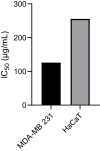Two Novel Compounds Isolated from the Marine Fungal Symbiont of Aspergillus unguis Induce Apoptosis and Cell Cycle Arrest in Breast Cancer Cells: In vitro Study
- PMID: 39867869
- PMCID: PMC11766706
- DOI: 10.2147/JEP.S494777
Two Novel Compounds Isolated from the Marine Fungal Symbiont of Aspergillus unguis Induce Apoptosis and Cell Cycle Arrest in Breast Cancer Cells: In vitro Study
Abstract
Purpose: A promising feature of marine sponges is the potential anticancer efficacy of their secondary metabolites. The objective of this study was to explore the anticancer activities of compounds from the fungal symbiont of Aaptos suberitoides on breast cancer cells.
Methods: In the present research, Aspergillus unguis, an endophytic fungal strain derived from the marine sponge A. suberitoides was successfully isolated and characterized. Subsequently, ethyl acetate extraction and isolation of chemical constituents produced was performed. The structures of the isolated compounds were identified using several spectroscopic methods, ie, UV, NMR, and mass spectrometry. Thereafter, MDA-MB-231, MCF-7 breast cancer cells and HaCat cells were treated with the isolated compounds. Not only viability, apoptosis, and cell cycle analyses were conducted, but also the mRNA expression of MCL1, BCL2L1, AKT1 and CDK2 were evaluated.
Results: The extract showed cytotoxic activity in breast cancer cells. Two novel compounds were successfully isolated and identified, ie, Unguisol A (15.1 mg) and Unguisol B (97.9 mg). Both compounds share the same basic skeleton and comprise an aromatic ring which is attached to a sulphur-containing, seven-membered ring via an oxygen atom. This marked the first-time isolation of Unguisol A and Unguisol B from A. unguis, highlighting their novelty. Both compounds induced early apoptosis (p < 0.01) and cell cycle arrest at the S phase (p < 0.05) in MDA-MB-231 cells, but not in HaCat cells. Both compounds suppressed BCL2L1 and AKT1 mRNA expression (p < 0.01).
Conclusion: Two novel compounds were isolated from A. unguis. Unguisol A and Unguisol B induced apoptosis in MDA-MB-231 breast cancer cells via BCL2L1 mRNA downregulation, while both compounds induced cell cycle arrest at the S phase through AKT1 mRNA downregulation.
Keywords: Aspergillus unguis; Porifera; drug screening assays; triple negative breast neoplasms.
© 2025 Bashari et al.
Conflict of interest statement
The authors report no conflicts of interest in this work.
Figures







Similar articles
-
Marine seaweed endophytic fungi-derived active metabolites promote reactive oxygen species-induced cell cycle arrest and apoptosis in human breast cancer cells.Mol Biol Rep. 2024 May 5;51(1):611. doi: 10.1007/s11033-024-09511-8. Mol Biol Rep. 2024. PMID: 38704796
-
The Ethanol Extract of Marine Sponge Aaptos suberitoides Suppress Cell Viability, Cell Proliferation and Cell Migration in HER2-Positive Breast Cancer Cell Line.Asian Pac J Cancer Prev. 2021 Feb 1;22(S1):25-32. doi: 10.31557/APJCP.2021.22.S1.25. Asian Pac J Cancer Prev. 2021. PMID: 33576209
-
Pyoluteorin induces cell cycle arrest and apoptosis in human triple-negative breast cancer cells MDA-MB-231.J Pharm Pharmacol. 2020 Jul;72(7):969-978. doi: 10.1111/jphp.13262. Epub 2020 Apr 4. J Pharm Pharmacol. 2020. PMID: 32246778
-
Anticancer Activity of Aaptos suberitoides on Glioblastoma Multiforme Cell Line.Asian Pac J Cancer Prev. 2024 May 1;25(5):1815-1821. doi: 10.31557/APJCP.2024.25.5.1815. Asian Pac J Cancer Prev. 2024. PMID: 38809654 Free PMC article.
-
Secondary Metabolites Diversity of Aspergillus unguis and Their Bioactivities: A Potential Target to Be Explored.Biomolecules. 2022 Dec 6;12(12):1820. doi: 10.3390/biom12121820. Biomolecules. 2022. PMID: 36551248 Free PMC article. Review.
References
-
- Achmad A, Lestari S, Holik HA, et al. Highly specific L-type amino acid transporter 1 inhibition by JPH203 as a potential pan-cancer treatment. Processes. 2021;9(7):1170. doi:10.3390/pr9071170 - DOI
-
- Vasanthabharathi V. Bioactive potential of symbiotic bacteria and fungi from marine sponges. African J Biotechnol. 2012;11(29). doi:10.5897/AJB11.1378 - DOI
LinkOut - more resources
Full Text Sources
Research Materials
Miscellaneous

